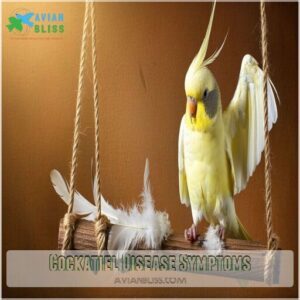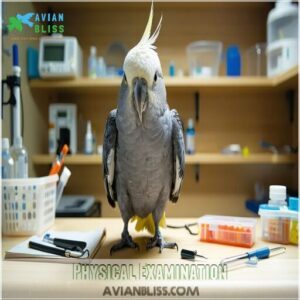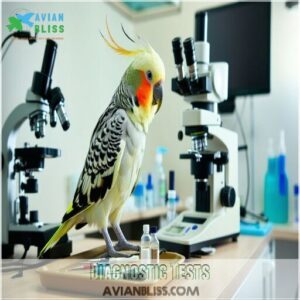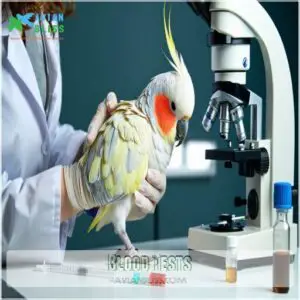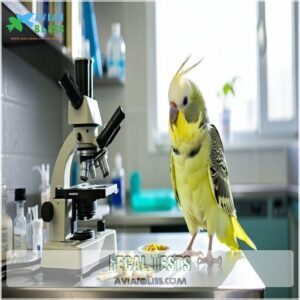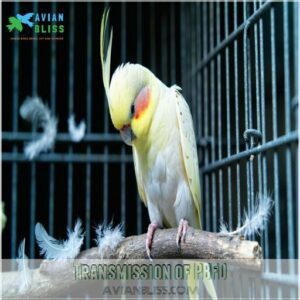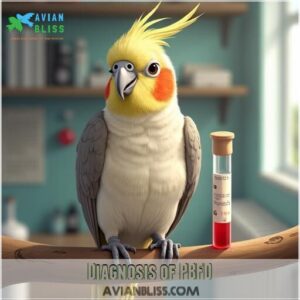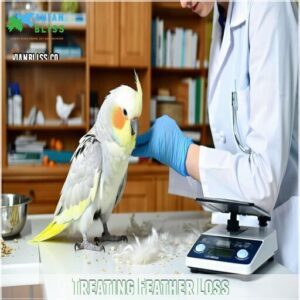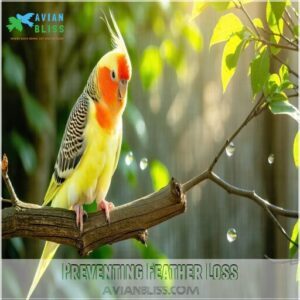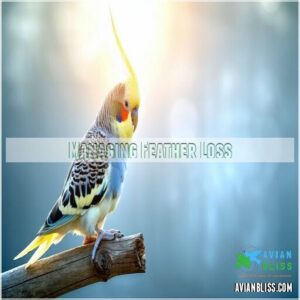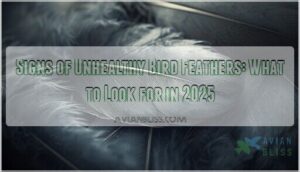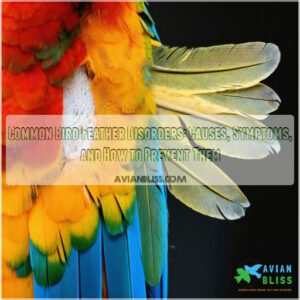This site is supported by our readers. We may earn a commission, at no cost to you, if you purchase through links.
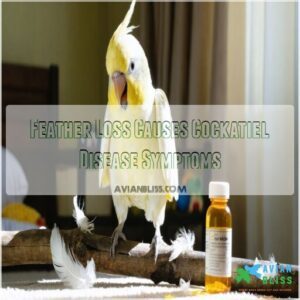
Feather loss causes in cockatiels range from medical issues like bacterial infections and PBFD to behavioral problems like stress-induced plucking.
Poor nutrition, especially vitamin A deficiency, can also leave your feathered friend looking bare.
Just like we need a doctor’s checkup, your bird needs an avian vet to identify the root cause through physical exams, blood work, and fecal tests.
Getting the right diagnosis means effective treatment – whether it’s medication, diet changes, or helping your bird feel more secure.
There’s more to those missing feathers than meets the eye.
Table Of Contents
- Key Takeaways
- Feather Loss Causes
- Cockatiel Disease Symptoms
- Diagnosing Feather Loss
- Psittacine Beak Disease
- Treating Feather Loss
- Preventing Feather Loss
- Managing Feather Loss
- Frequently Asked Questions (FAQs)
- What disease causes birds to lose feathers?
- Why is my cockatiel losing so many feathers?
- What is the feather disease in cockatiels?
- Do fallen bird feathers carry disease?
- Can feather loss indicate respiratory infections?
- How does molting differ from disease-related loss?
- Are certain cockatiel colors more susceptible?
- Can genetics influence feather loss patterns?
- Do hormonal changes cause seasonal feather loss?
- Conclusion
Key Takeaways
- You’ll need to identify the underlying cause of your cockatiel’s feather loss, and that starts with a thorough diagnosis, including physical exams, blood work, and fecal tests, to determine what’s causing the issue.
- Feather loss in cockatiels can be caused by various factors, including medical issues like bacterial infections and PBFD, behavioral problems like stress-induced plucking, and nutritional deficiencies, such as vitamin A deficiency.
- You can prevent feather loss in your cockatiel by maintaining a balanced diet rich in protein and essential fatty acids, ensuring proper cage hygiene, and providing a stress-free environment with adequate humidity and appropriate lighting.
- If you notice unusual plucking, bald patches, or behavior changes in your cockatiel, you should consult an avian vet immediately, as early intervention is essential to determine effective treatment and prevent serious feather loss and disease complications.
Feather Loss Causes
By identifying the underlying causes, you can take steps to address the issue and help your bird regain its healthy feathers.
It’s important to recognize that feather loss in cockatiels can be attributed to various medical, behavioral, or nutritional factors.
Understanding these causes is key to resolving the problem effectively.
Medical Causes of Feather Loss
You’ll encounter medical causes of feather loss, including bacterial infections, viral diseases, and fungal infections, which can lead to skin irritation and parasite infestations, affecting your cockatiel’s health, such as psittacine beak and feather disease, causing feather plucking and loss, a common avian disease.
Feather loss can also be caused by various factors, including feather damage issues, which can have a significant impact on a bird’s overall health.
Behavioral Causes of Feather Loss
You’ll notice feather picking, a common behavioral cause of feather loss, often resulting from psychological problems like boredom, stress factors, and social isolation, leading to compulsive feather plucking and destructive behavior.
Feather loss can be caused by various factors, including feather loss issues that may require professional diagnosis and treatment.
Nutritional Causes of Feather Loss
You’ll find that nutritional causes, like vitamin A deficiency, can lead to feather loss.
As a poor diet affects overall health, it potentially causes malnutrition and related diseases, including issues like fatty acid deficiency or protein deficiency.
Cockatiel Disease Symptoms
You’ll notice that cockatiel disease symptoms can be alarming, especially when they’re related to feather loss.
As you explore the possible causes, you’ll find that diseases like psittacine beak and feather disease, bacterial infections, and parasites can all contribute to feather loss in cockatiels.
Space Exploration Costs
You’re exploring space costs, a huge leap from cockatiel feather loss.
Galactic travel requires a massive Space Budget, considering Rocket Expenses and Orbital Fees.
Whereas avian feather loss has its own Cosmic Funding concerns, like treating cockatiel disease and understanding feather loss causes.
Alien Life Forms
You’re unlikely to find Alien Life Forms causing cockatiel disease.
- Extraterrestrial Life
- Space Colonies
- Alien Biology
- Cosmic Evolution
are unrelated to Psittacine Beak and Feather Disease, or PBFD, also known as Psittacine Circoviral Disease, PCD, and circovirus.
Galaxy Dark Matter
You’re now exploring Galaxy Dark Matter, a topic far from Alien Life Forms.
Dark Matter affects galaxy formation, including black holes and cosmic dust, but it won’t cause feather loss disease in your cockatiel, a concern for bird health and cockatiel illness, related to feather loss.
Understanding broken blood feathers is essential for addressing potential health issues in cockatiels, particularly those related to feather loss and cockatiel illness.
Diagnosing Feather Loss
You’ll need to identify the underlying cause of your cockatiel’s feather loss, and that starts with a thorough diagnosis.
You can work with a veterinarian to conduct a physical examination, diagnostic tests, and other evaluations to determine what’s causing your bird’s feather loss.
Physical Examination
You’ll perform a visual inspection, feather palpation, and beak examination to assess feather loss in cockatiels, including skin checks and plumage assessment, essential for diagnosing feather loss disease and understanding cockatiel health.
Understanding feather loss causes is essential for effective diagnosis and treatment of the condition.
Diagnostic Tests
To diagnose feather loss in cockatiels, your vet may recommend several diagnostic tests.
These can include:
- Fecal direct smear to detect parasites or yeast infections
- Fecal gram stain to identify bacterial infections
- DNA/RNA tests to diagnose viral or bacterial infections
- X-rays to rule out respiratory infections or tumors
These tests help pinpoint the underlying cause of feather loss, guiding effective treatment.
Blood Tests
A detailed Blood Panel serves as an essential diagnostic tool when investigating feather loss in cockatiels.
Your avian veterinarian will likely recommend CBC (Complete Blood Count) and Biochemistry tests to reveal underlying infections or organ dysfunction.
Hematology can identify inflammation markers while Serology detects antibodies for specific diseases.
Blood tests provide valuable insights into your bird’s health status that might explain feather damage, though they’re just one piece of the diagnostic puzzle to help understand the underlying cause of the feather loss.
Fecal Tests
Beyond blood work, your veterinarian will need fecal tests to fully assess your bird’s health.
These stool exams can reveal hidden parasites, bacterial imbalances, and other gut health problems that might contribute to feather loss.
Through careful fecal analysis and microbial tests, your vet can detect various avian diseases that affect cockatiels.
Regular parasite detection screenings help maintain your bird’s overall wellbeing and prevent future complications, which is crucial for maintaining overall wellbeing.
Psittacine Beak Disease
You’ll notice signs of Psittacine Beak Disease when your cockatiel’s feathers become disfigured and fall out easily, often accompanied by beak damage.
If your bird shows these symptoms, you’ll need immediate veterinary care since this viral disease suppresses the immune system and can be fatal without proper medical attention, which is why proper medical attention is crucial.
Clinical Signs of PBFD
During the early stages of PBFD, you’ll notice scattered yellow feathers appearing in green-plumaged birds.
The viral infection progresses with symmetrical feather loss and clumping, often accompanied by skin lesions.
Your bird may show signs of lethargy, decreased appetite, and diarrhea.
As the disease advances, beak deformity develops, making eating difficult.
Watch for a general ‘grubby‘ appearance and progressive feather damage with each molt.
Transmission of PBFD
The invisible threat of PBFD spreads through direct contact with infected birds and contaminated environments.
Viral spread occurs via feather contact, airborne transmission, or ingestion of contaminated materials.
Unlike many avian circoviruses, this Circovirus rarely affects cockatiels, making them a notable exception among over 50 susceptible species.
Stress triggers asymptomatic carriers to shed virus.
You’ll minimize contagion risk by screening new birds and practicing strict isolation protocols.
Understanding psittacine beak disease is paramount for effective prevention and management of the condition.
Diagnosis of PBFD
The diagnosis of PBFD requires a systematic approach using multiple testing methods to confirm the presence of this devastating virus.
Your veterinarian will employ several diagnostic tools to identify PBFD accurately.
- Blood screening detects viral DNA before visible symptoms appear
- Feather analysis reveals characteristic damage patterns
- Skin biopsy confirms viral presence in affected tissues
- Beak inspection identifies early deformities
- PCR testing provides definitive molecular diagnosis
These diagnostic steps are essential for early intervention and management of cockatiel disease symptoms related to PBFD.
Through thorough viral testing, your vet can develop an appropriate care plan for your feathered friend, ensuring the best possible outcome for your pet, which is crucial for managing PBFD symptoms.
Treating Feather Loss
You’ll need to combine medical treatments, behavioral modifications, and dietary changes to effectively address your cockatiel’s feather loss.
Your veterinarian can help you develop a personalized treatment plan that targets the specific cause of the feather loss, whether it’s due to infection, stress, or nutritional deficiencies.
Medical Treatment
Your cockatiel’s medical treatment plan will depend on the underlying cause of feather loss.
Injectable antibiotics like zosyn and amikacin target bacterial infections, while antiviral medications help manage conditions like circovirus.
For fungal or parasitic issues, your vet may prescribe specific medications.
Treatment typically includes pain management to keep your bird comfortable, and regular monitoring verifies the therapy’s effectiveness through the recovery period.
Understanding feather loss causes is essential for effective treatment and prevention of further complications.
Behavioral Treatment
Behavior modification experts recommend professional help for persistent feather destructive behavior.
You’ll need patience as treatment may take months to show results.
Implement consistent stress reduction techniques to break the endorphin-release cycle that reinforces feather picking.
- Introduce enrichment activities like puzzle toys to redirect destructive urges
- Monitor social interaction with cage mates for at least six weeks
- Consider pharmacological support like naltrexone (1.5 mg/kg twice daily) for severe cases, which can help in breaking the cycle of feather picking.
Dietary Changes
While behavioral interventions help, your cockatiel’s feather problems often start on their plate.
Switching from an all-seed diet to a balanced one rich in protein prevents keratin deficiency that weakens feathers.
Consider necessary cockatiel food supplements to guarantee proper nutrition.
Your bird needs fatty acids and Vitamin A from fruits and vegetables—aim for 20-25% of their daily intake.
Low protein levels directly impact feather structure, so dietary changes may take months but offer lasting solutions to feather loss.
Preventing Feather Loss
You’ll prevent feather loss in your cockatiel by maintaining a balanced diet rich in protein and essential fatty acids.
While ensuring proper cage hygiene, a stress-free environment with adequate humidity and appropriate lighting will greatly reduce the risk of bacterial infections and destructive feather behavior, promoting a healthy and stress-free space.
Proper Nutrition
A balanced diet prevents nutritional diseases that can trigger feather loss in your feathered friend.
You’ll want to provide a mix of healthy foods, including fresh vegetables, quality pellets, and carefully measured vitamin supplements.
Consider cockatiel food supplements for best nutrition.
Watch for signs of nutrient deficiency, which can lead to metabolic bone disease (MBD) and other bird health problems.
Your cockatiel’s mineral intake needs special attention – think of it as building blocks for strong feathers, which are crucial for your bird’s overall health and well-being, and require careful management to prevent issues like nutrient deficiency.
Hygiene and Sanitation
Regular cage cleaning forms the foundation of preventing feather loss and skin infections in your cockatiel.
You’ll want to disinfect food bowls daily, replace cage liners weekly, and deep clean perches monthly to prevent parasites.
Pay special attention to your bird’s feather care by monitoring for signs of mites or bacterial growth.
Maintaining pristine air quality through proper ventilation helps reduce respiratory issues and promotes healthy plumage.
Environmental Factors
Beyond maintaining a clean space, your cockatiel’s environment plays an essential role in preventing stress-induced feather loss.
The right balance of environmental factors helps protect your bird’s plumage from damage.
Here’s what you’ll need to monitor:
- Temperature Control and humidity levels should mirror their natural habitat – warm but not hot
- Proper lighting effects their mood and feather health
- Air quality and noise pollution can trigger cage trauma
You can prevent plumage damage by adjusting these factors seasonally, just like your feathered friend would experience in the wild, and maintain a clean space to ensure their overall well-being and feather health.
Managing Feather Loss
You’ll need to closely monitor your cockatiel’s feather condition and maintain a detailed record of any changes to help your veterinarian develop an effective treatment plan.
Working with your vet, you can create a detailed care strategy that includes proper nutrition, environmental adjustments, and regular health checks to manage your bird’s feather loss effectively.
Home Care
While prevention tactics help, home care practices are your front line against bird feather loss.
Daily attention makes healing possible.
Providing the right feather supplements is essential for supporting the overall health of your cockatiel.
| Home Care Action | Benefits |
|---|---|
| Cage Cleaning (twice weekly) | Prevents bacterial infections |
| Bird Grooming (gentle misting) | Soothes irritated skin |
| Feather Supplements (vet-approved) | Supports healthy regrowth |
| Humidity Control (40-60%) | Reduces discomfort and plucking |
| Lighting Adjustment (12hr cycles) | Decreases stress-related damage |
The key to successful home care is implementing these practices consistently, with daily attention and the right feather supplements making a significant difference in your cockatiel’s health, and ensuring humidity control and proper lighting adjustment to reduce stress and discomfort.
Veterinary Care
While providing home care is important, professional veterinary care is critical when your cockatiel shows persistent feather loss.
Schedule regular appointments with an avian vet who specializes in bird surgery and disease diagnosis.
Your cockatiel vet might recommend specific tests, medication, or pet rehabilitation protocols depending on the underlying cause.
In emergency care situations, don’t wait – feather picking can quickly escalate to self-mutilation requiring immediate avian therapy.
Ongoing Monitoring
After veterinary visits, you’ll need to track your cockatiel’s feather health through daily observation.
Keep a detailed log of any bird feather problems, noting changes in appearance or behavior.
Monitor environmental factors like humidity and temperature, as they can trigger avian feather disorders and feather plucking.
Schedule routine health checks, and stay informed about cockatiel symptoms through owner education resources, which helps your watchful eye catch issues early.
Frequently Asked Questions (FAQs)
What disease causes birds to lose feathers?
Your feathered friends may experience plumage issues from several conditions.
PBFD, polyoma virus, bacterial infections like Staphylococcus, parasites such as Giardia, and stress-related behavioral disorders can all cause birds to lose their feathers, which is a significant issue related to plumage.
Why is my cockatiel losing so many feathers?
Your cockatiel might be molting (normal), experiencing stress, nutritional deficiencies, or medical issues like parasites or PBFD.
Check for abnormal patterns and consult your vet if feather loss seems excessive or concerning, as it could indicate medical issues.
What is the feather disease in cockatiels?
Like a silent thief, Psittacine Beak and Feather Disease (PBFD) is the most serious feather disease in cockatiels.
It’s a viral infection that causes feathers to become disfigured and fall out easily.
Do fallen bird feathers carry disease?
Yes, fallen bird feathers can carry diseases like Psittacine Beak and Feather Disease virus and bacteria.
You should avoid touching wild bird feathers and wash your hands if you do handle them.
Can feather loss indicate respiratory infections?
Respiratory troubles often lurk behind feather problems. You’ll notice your cockatiel might lose feathers when fighting respiratory infections, as their body diverts energy from feather maintenance to combat illness.
How does molting differ from disease-related loss?
Molting is a normal cyclical process where feathers are naturally replaced in a predictable pattern.
Disease-related loss typically occurs irregularly, may show inflammation, affects specific body areas, and isn’t symmetrical like normal molting.
This process can be distinguished from normal molting by its irregularity and other characteristics, such as inflammation, and the fact that it affects specific body areas in a non-symmetrical manner.
Are certain cockatiel colors more susceptible?
Studies show 80% of Lutino cockatiels develop bald spots on their head.
You’ll notice that Lutinos and Pearls are particularly susceptible to feather loss, while inbred color mutations generally face more health challenges due to genetic factors.
Can genetics influence feather loss patterns?
Genetics can definitely influence feather loss patterns in your cockatiel.
You’ll notice certain mutations, like lutinos, may be predisposed to baldness around the head, while recessive pied cockatiels might experience different feathering issues altogether.
Do hormonal changes cause seasonal feather loss?
While natural molting follows seasonal patterns, hormonal surges trigger different feather behaviors. You’ll notice your cockatiel might pluck from frustration during breeding season when daylight changes affect their circadian rhythm.
Conclusion
Remember, addressing feather loss causes in cockatiels requires swift action. Like a knight protecting their castle, you’re your bird’s first line of defense against disease.
Watch for unusual plucking, bald patches, or behavior changes. Consult an avian vet immediately if symptoms appear—proper diagnosis determines effective treatment.
Whether it’s nutritional deficiencies, bacterial infections, or stress-induced plucking, early intervention is essential. With proper care and vigilance, you’ll help your feathered friend maintain healthy plumage and prevent serious feather loss causes cockatiel disease complications.
- https://www.justanswer.com/bird-vet/ffr5q-male-cockatiel-losing-feathers-around-neck-top.html
- https://lafeber.com/pet-birds/questions/cockatiel-losing-feathers-around-eye/?srsltid=AfmBOop8LzfbnJjJ_upIhLwFZ2jmIN71wQM4_EbMARcmYzz1QljFDzkr
- https://www.merckvetmanual.com/multimedia/table/feather-loss
- https://vcahospitals.com/know-your-pet/feather-problems-in-birds
- https://www.reddit.com/r/cockatiel/comments/148nbrn/cockatiel_lost_feathers_under_wings/


